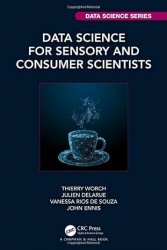 Название: Data Science for Sensory and Consumer Scientists
Название: Data Science for Sensory and Consumer ScientistsАвтор: Thierry Worch, Julien Delarue, Vanessa Rios De Souza, John Ennis
Издательство: Springer
Серия: Data Science Series
Год: 2024
Страниц: 349
Язык: английский
Формат: pdf (true), epub
Размер: 25.9 MB
Data Science for Sensory and Consumer Scientists is a comprehensive textbook that provides a practical guide to using Data Science in the field of sensory and consumer science through real-world applications. It covers key topics including data manipulation, preparation, visualization, and analysis, as well as automated reporting, Machine Learning, text analysis, and dashboard creation. Written by leading experts in the field, this book is an essential resource for anyone looking to master the tools and techniques of data science and apply them to the study of consumer behavior and sensory-led product development. Whether you are a seasoned professional or a student just starting out, this book is the ideal guide to using data science to drive insights and inform decision-making in the sensory and consumer sciences.
R is a scripting language (not a compiled language) that runs the lines of code or commands one by one, in order. It is one of the most popular languages used by statisticians, data analysts, researchers, marketers, etc. to retrieve, clean, analyze, visualize, and represent data. By the time this book is being written, it is among the most popular programming languages in the world, including the sensory and consumer science field.
There are several reasons why you should learn R or any programming language for that matter. First, it gives the user a lot of control. Compared to other statistical software, which can be seen as a black box (you do not have necessarily access to the code that runs behind the scene) and are restricted to the features their developers provide, R allows you to see what is happening at each step of your analysis (you can print the code that runs behind each function to ensure that it does what you are expecting...) and allows exploring any type of analysis.
However, with a programming language, you can update all your tables, figures, and reports by simply applying to the new data your previous scripts. Such solution brings us to the next reason, which is related to abstract thinking and problem-solving mindset. These are the two components that are necessary to acquire good programming skills (no worries if you’re not confident in having that in you yet; the more you program, the more you’ll develop these skills) and thus increasing your capability through continuous improvement. In other words, the more you play with your data, try new things, etc., the more you’ll improve as a programmer, and most importantly, the more diverse and flexible you’ll become.
One of the main goal of data analysis is to produce results. Although infor mative, such results are only impactful if they can be well-communicated. It is hence of utmost importance to present them in a neat way, often through visuals. In this chapter, two forms of visuals (namely tables and graphs) are being generated using R. Although some design principles are being tackled, the aim of this chapter is to mainly focus on the how to? rather than on the design itself. Although R already comes with tools for building and printing tables and graphs, we opt for using additional packages ({flextable} and {gt} for tables, {ggplot2} for graphs) as they provide more flexibility and possibilities.
Artificial Intelligence (AI) and Machine Learning (ML) have gained a lot of attention in recent years. With the increase in data availability, data storage, and computing power, many techniques that were just dreams back then are now easily accessible and used. And of course, the sensory and consumer science field is not an exception to this rule as we start seeing more and more ML applications although in our case, we do not have Big Data per se, but we do have diverse data! For many of us, AI and ML seems to be a broad and complex topic. This assertion is true, and in fact it would deserve a whole book dedicated just to it. However, our intention in this chapter is to introduce and demystify the concept of ML, by: (1) explaining the differences between supervised and unsupervised ML models, (2) proving that you were already doing it long ago, perhaps without knowing, (3) extending it to more advanced techniques, (4) highlighting its main applications in the field. To do so, some basic code and steps will be provided to the reader to get familiar with such approach.
Who Should Read This Book?
This book is for practitioners and students of sensory and consumer science who want to participate in the emerging field of computational sensory science. This book assumes little to no coding experience. Some statistical experience will be helpful to understand the examples discussed.
Скачать Data Science for Sensory and Consumer Scientists